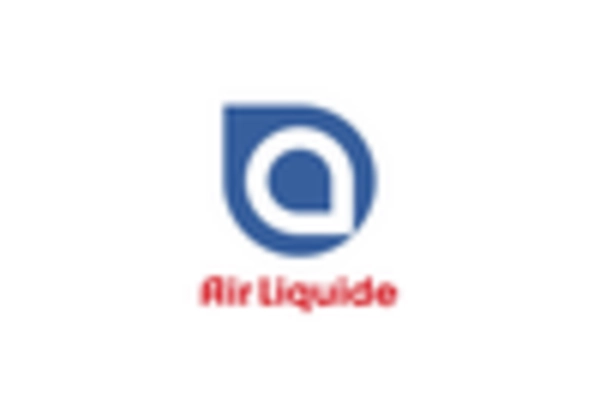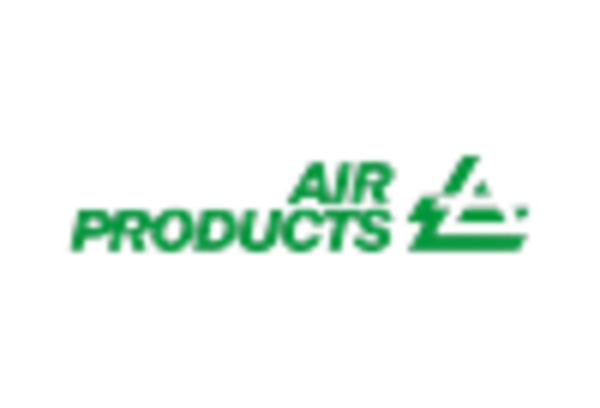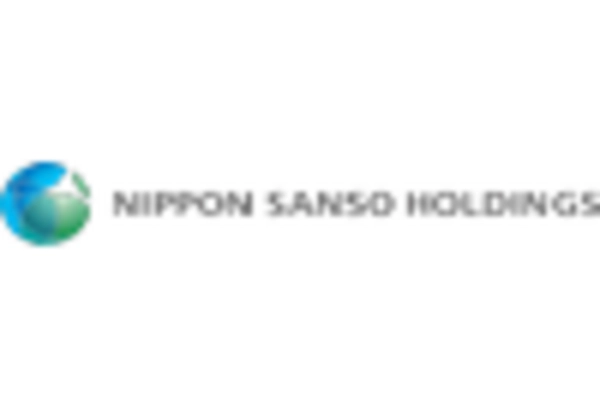Increasing Focus on Energy Efficiency
Energy efficiency is becoming a central focus within the Industrial Gases Glass Market, as manufacturers strive to reduce operational costs and environmental impact. The glass production process is energy-intensive, and the adoption of energy-efficient technologies is essential for sustainability. Industrial gases play a pivotal role in enhancing energy efficiency, particularly in processes such as combustion and heating. The market is witnessing a shift towards the use of alternative fuels and gases that offer lower carbon footprints. This transition is likely to drive demand for industrial gases that support energy-efficient glass production. As energy regulations become stricter, the Industrial Gases Glass Market may see a surge in investments aimed at optimizing energy consumption and reducing greenhouse gas emissions.
Expansion of Renewable Energy Applications
The expansion of renewable energy applications is significantly impacting the Industrial Gases Glass Market. As the world moves towards sustainable energy solutions, the demand for glass components in solar panels and wind turbines is increasing. Glass plays a critical role in the efficiency and durability of these renewable energy technologies. The market for industrial gases used in the production of solar glass is expected to grow, driven by the rising adoption of solar energy systems. Furthermore, the integration of industrial gases in the manufacturing of glass for energy applications is likely to enhance product performance. This trend suggests a promising future for the Industrial Gases Glass Market, as it aligns with global efforts to transition to cleaner energy sources.
Rising Demand for Specialty Glass Products
The Industrial Gases Glass Market is experiencing a notable increase in demand for specialty glass products, driven by various sectors such as automotive, electronics, and construction. Specialty glass, which includes products like glass ceramics and glass composites, is essential for applications requiring high durability and thermal resistance. The market for specialty glass is projected to grow at a compound annual growth rate of approximately 5.5% over the next few years. This growth is largely attributed to the expanding automotive industry, where lightweight and high-strength materials are increasingly favored. As manufacturers seek to enhance product performance and sustainability, the Industrial Gases Glass Market is likely to benefit from this trend, leading to increased consumption of industrial gases used in glass production.
Innovations in Glass Manufacturing Processes
Innovations in manufacturing processes are significantly influencing the Industrial Gases Glass Market. Advanced techniques such as 3D printing and automated glass production are becoming more prevalent, allowing for greater precision and efficiency. These innovations not only reduce production costs but also minimize waste, aligning with sustainability goals. The integration of industrial gases in these processes is crucial, as they are used for various applications, including melting and refining glass. The market for industrial gases in glass manufacturing is expected to expand, with estimates suggesting a growth rate of around 4% annually. This trend indicates a shift towards more efficient and environmentally friendly production methods, which could reshape the landscape of the Industrial Gases Glass Market.
Regulatory Support for Sustainable Practices
Regulatory support for sustainable practices is shaping the Industrial Gases Glass Market. Governments worldwide are implementing policies aimed at reducing carbon emissions and promoting environmentally friendly manufacturing processes. These regulations often encourage the use of industrial gases that have lower environmental impacts. Compliance with these regulations is becoming increasingly important for manufacturers in the glass industry, as non-compliance could lead to penalties and loss of market access. The Industrial Gases Glass Market is likely to see a shift towards gases that meet stringent environmental standards, fostering innovation and investment in cleaner technologies. This regulatory landscape may drive the adoption of sustainable practices, ultimately benefiting the market as a whole.


















Leave a Comment